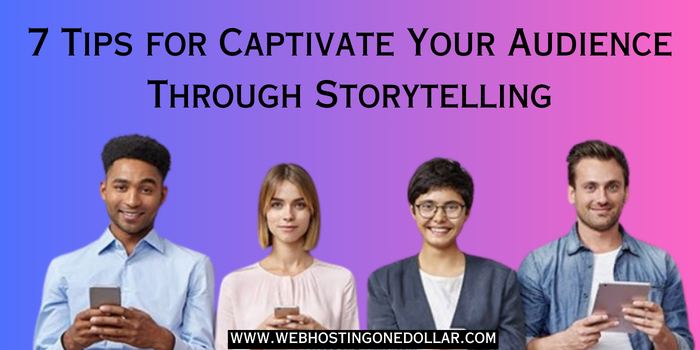
In today’s digital age, Captivate your grabbing your audience’s attention is no easy task. You may not have much time or patience to read. Sometimes, you may even jump over some lines to reach the conclusion faster!
Storytelling is a potent skill that enables you to bond, communicate clearly, and differentiate yourself in the digital space. Stories can make content more appealing, whether you are reaching out to a large audience or giving a formal presentation. The main objective is to captivate your listeners, and learning the craft of storytelling is a priceless skill.
In this article, we’ll share several essential tips for keeping your audience hooked through the magic of storytelling. Maybe you want to convey a moral, evoke emotions, or just present a unique perspective; whatever your aim, these tips will ensure your audience stays curious and eager to hear (and see) what you have to say and show.
1. Know Your Audience
To effectively communicate and express your thoughts, it’s essential to know the individuals you are addressing. Tailoring your story to resonate with their mindset and emotional level is the first step. If your story doesn’t align with their demographic or psychographic aspects, it may not capture their interest.
Moreover, knowing captivate your audience helps determine the appropriate tone and language. Understanding what they can comprehend ensures effective communication. Cultural background plays a significant role, too. Being aware of your audience’s values, norms, preferences, and even religious beliefs prevents misjudgments and misinterpretations. Ultimately, the goal is to captivate them by aligning your narrative with their expectations.
2. Utilize Visuals
Including visuals in your storytelling enhances the overall experience for your audience. Visual elements can instantly capture their attention and make your narrative more engaging. Whether it’s a compelling image, interesting stock video footage, or relevant illustrations and graphs, visuals help convey complex information in a more understandable and interesting way.
Moreover, visuals establish a strong connection between the storyteller and the audience. Regardless of the form of visual content used, it creates a higher level of connection and allows people to feel, experience, and imagine themselves within the story. The beauty of incorporating visuals is that people are more likely to remember the images or videos long after the story is told, reinforcing the impact of your narrative.
3. Create Relatable Characters and Situations
A good storyteller knows how to make the audience feel connected by creating characters and situations that they can relate to. This connection is not just superficial, but deep and meaningful. Choose topics such as personal growth, loss, friendship, and self-discovery. By incorporating these universally felt themes, your story will strike a chord with a diverse audience, making it more engaging and relatable.
Additionally, crafting characters that mirror real-life traits and vulnerabilities allows the audience to see themselves in the story. They empathize with the characters’ weaknesses and cheer for their strengths, making the story more enjoyable to engage with.
4. Inject Emotion
To further engage your audience through storytelling, another effective technique is to evoke emotions. This means guiding your audience through a range of feelings, whether it’s happiness, sadness, surprise, confusion, or sympathy. By making them experience different emotions during your story, you create a powerful impact and a lasting impression.
Creating suspense is also essential – it adds excitement or fear, keeping the audience on an emotional roller coaster as they become invested and eager to know what happens next.
However, steer clear of anything that might hit too close to home or stir up strong emotions. The goal is for the audience to feel a natural connection, making the storytelling engaging and relatable rather than insensitive or offensive.
5. Keep it Concise
Present your information without unnecessary details or dragging the story. This ensures your audience stays connected without losing interest. Make your message crystal clear, allowing the audience to easily grasp the purpose behind your story. Avoid overwhelming them with irrelevant information, unnecessary plot extensions, or meaningless details about characters.
To keep it concise, start by identifying the core message you want to convey. Understand what you want to captivate your audience to take away and prioritize essential elements and key points. Choose words carefully, opting for phrases or sentences that convey your ideas briefly. The goal is to ensure your audience easily grasps and comprehends your message without feeling overwhelmed by unnecessary information.
6. Maintain Authenticity
Read this carefully – when people hear a story, they want it to feel genuine and believable.
Avoid forcing details or using clichés that might make your story sound too made-up. Stay away from forced dialogues or twists just to make it surprising or interesting because people can quickly sense when something doesn’t feel real. If they feel it’s not believable, they might lose interest and ignore your message.
Know your characters well; understand their traits. Avoid sudden changes in their actions or characteristics that don’t align with who they are. Extensive research about the characters and backgrounds you include in your story adds credibility and builds trust and connection between the storyteller and the audience. People engage more with stories and situations that feel honest and evoke genuine emotions. This authenticity is what will truly captivate your audience.
7. End with Impact
The story’s ending matters as much as it’s telling. Make sure to captivate Your audience remember your conclusion and feel its impact.
Crafting a well-thought-out ending provides the closure that every audience craves. A story that captivates the audience makes them curious about the fate of the characters and the outcome of the events. To spice up your story, add some surprising turns at the end that will make it unforgettable for your readers. You can even include subtle hints or elements throughout the story that lead to the conclusion, adding to its believability and impact.
Always revisit the main idea or message you focused on throughout the story, ensuring that Your audience understands the actual message behind your narrative.
Conclusion
Storytelling is an integral skill in our fast-paced global. With such a lot of distractions and demands, we need to speak our thoughts in a method that is brief, clear, and engaging. Storytelling isn’t something you may grasp in an afternoon; it takes time and exercise to hone your craft. The recommendations we furnished are virtually going to help you beautify your storytelling competencies, and shortly, you’ll come to be a pro at it!






